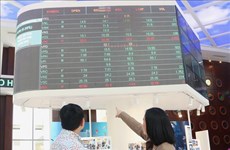How will USD exchange rate move in 2019?
 Illustrative image (Source: VietnamPlus)
Illustrative image (Source: VietnamPlus)
Hanoi (VNA) – Experts have predicted that the State Bank of Vietnam (SBV) will hike the VND/USD exchange rate by 1.5-2 percent in 2019 to stabilise the macro-economy and facilitate exports.
Officials from the Military Bank Securities Company (MBS) said the VND/USD exchange rate fluctuated sharply in 2018. After a slight increase in the first half of the year, the rate surged in June and July before cooling down in the final three months. On the full-year calculation, it rose by 2.6 percent. Though not as stable as in 2017, it remained a bright spot of the Vietnamese economy while regional countries were forced to devaluate their currencies due tothe rising dollar.
The State Bank has adopted a flexible managing policy and started intervening in the market by selling US dollar to stabilise market sentiment, an MBS expert said.
Also according to the MBS, pressure on the VND/USD exchange rate is likely to ramp up when the greenback trends up in the global market in the near future. The process of normalising the US Fed’s monetary policy continues to fuel rising momentum of the US dollar but it is not too worrying. The VND/USD exchange rate at commercial banks stood at 23,250 VND as of January 4, 2019.
Moreover, foreign exchange reserves were maintained at a fairly high level of 63.5 billion USD, as the SBV bought in 11 billion USD in 2018 to stabilise the exchange rate. In 2019, the SBV is capable of managing the flexible exchange rate thanks to abundant supply of US dollars and stable macro-economic balance.
The SBV still set a 0 percent interest rate for USD deposits for both individual and entity customers. Meanwhile, the VND deposit rate has been stable since the beginning of this year. The difference between USD and VND deposit interest rates is quite high amid moderate inflation, prompting people to sell US dollars and hold Vietnamese dong, making it easier for the SBV to maintain a reasonable VND/USD exchange rate.
"The US dollar is likely to peak and go down slightly in 2019 when the US economy recorded peak growth in 2018 (with a 2019 GDP growth forecast at 2.3 percent), forcing the Fed to ease pressure on interest rate hike. This will not put a strong pressure on Vietnamese dong, so we predict that the SBV will heighten the VND/USD rate by about 1.5-2 percent in 2019 to stabilise the macro-economy and facilitate exports,” an MBS expert said.
Additionally, Vietnam's trade surplus of 7.2 billion USD in 2018 will drive the stability of exchange rates in Vietnam. Foreign exchange reservesare likely to edge up when the trend continues. At present, it is 21.9 billion USD higher than the short-term foreign currency debt of the economy, so the MBS predicts the risk of an exchange rate rise in 2019 is quite low.
Agreeing, General Director of the HSBC Vietnam Pham Hong Hai said the Fed is likely to stop raising the interest rate after two upwards adjustments in 2019, so it will be hard for the US dollar to maintain the uptrend. Therefore, the pressure on the USD/VND exchange rate will also decrease and the VND will return to the narrow exchange rate adjustment range in 2019, except for the strong depreciation of the Chinese yuan.
A report by Bao Viet Securities Company (BVSC) also said the Vietnamese dong was one of the best currencies resilient to Fed rate hikes. Vietnam was also the only country in Southeast Asia to not raise its operating interest rate in 2018.
The SBV mainly kept Vietnamese dong from depreciation bylessening liquidity from the banking system, creating a shortage of Vietnamese dong and protecting the value of the currency.
In addition, Vietnam has posted a trade surplus since 2016, different from 2015 and 2007-2011. The surplus comes from both the current account and capital balances. It is forecast the surplus will continue in 2019 thanks to export growth, FDI attraction and stable remittance flows.
The Vietnamese dong always adjusted towards devaluation compared to the US dollar while the Chinese yuan fluctuates from time to time and the Chinese government often devaluates the yuan when its economy is in trouble.
“The Chinese yuan is forecast to depreciate by below 5%, lower than that in 2018. Therefore, the pressure on VND devaluation due to yuan’s movements in 2019 will be lower than in 2018. On such basis, the VND risk of going down by 5 percent next year is not big. We forecast that the Vietnamese dong will fall by less than 3 percent in 2019,” a BVSC expert said.-VNA













